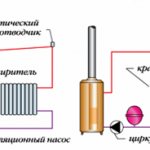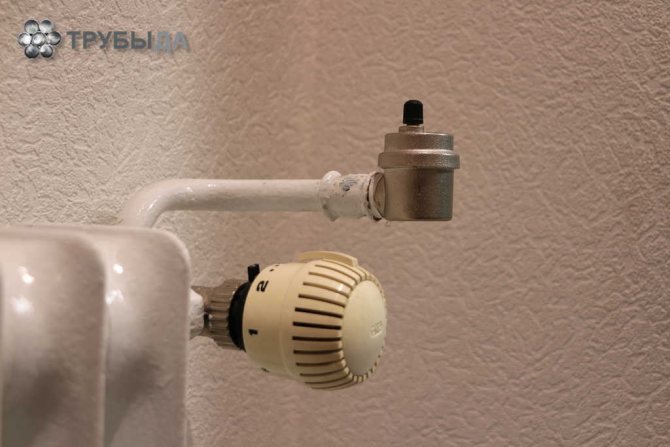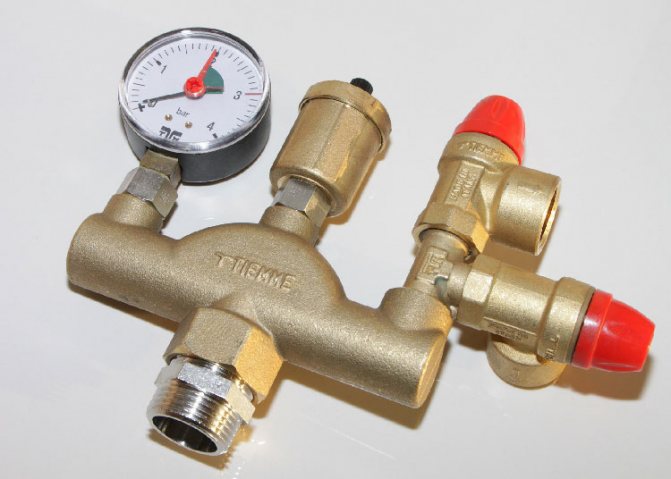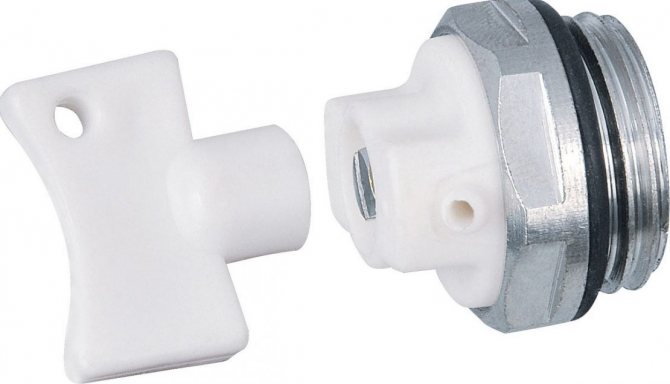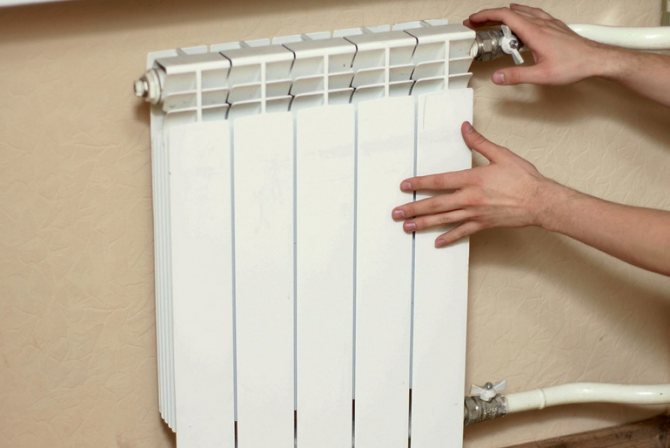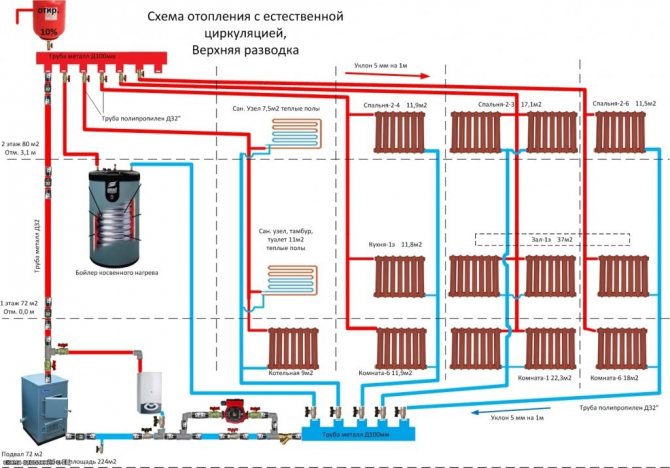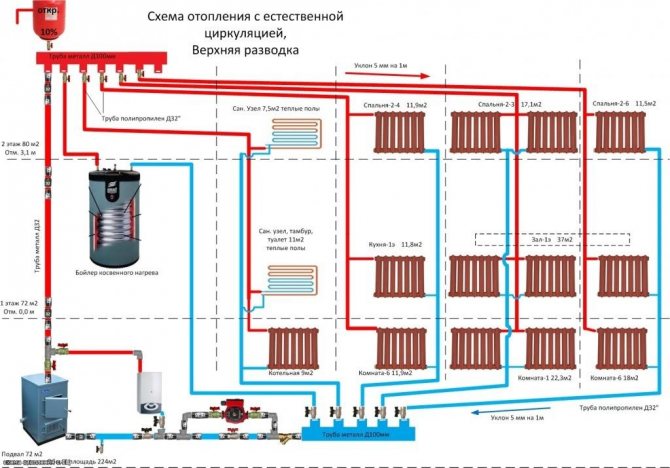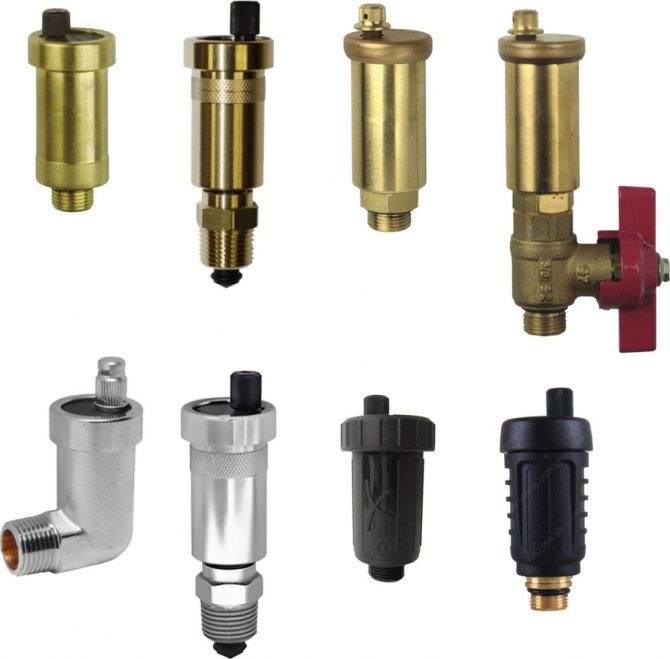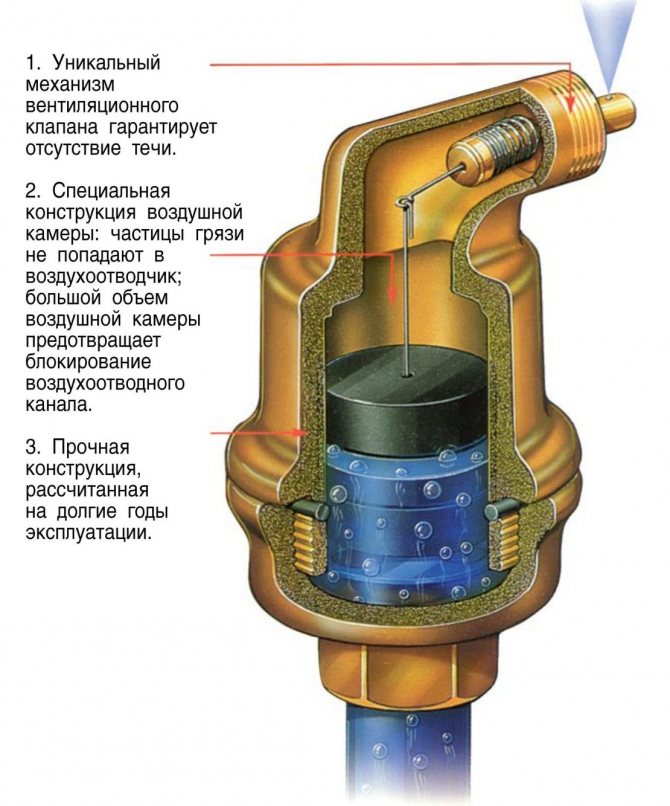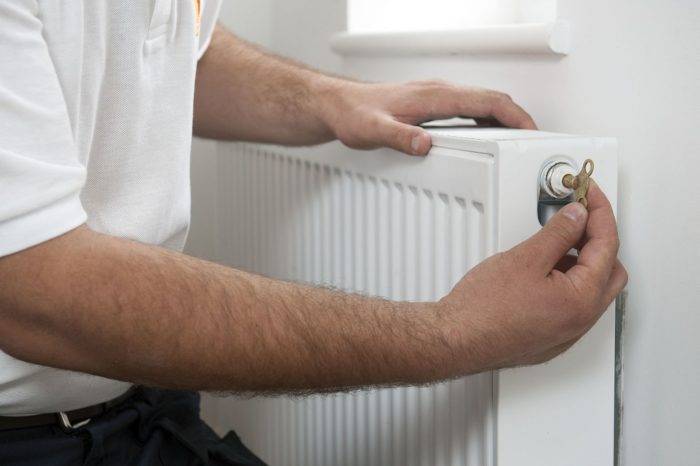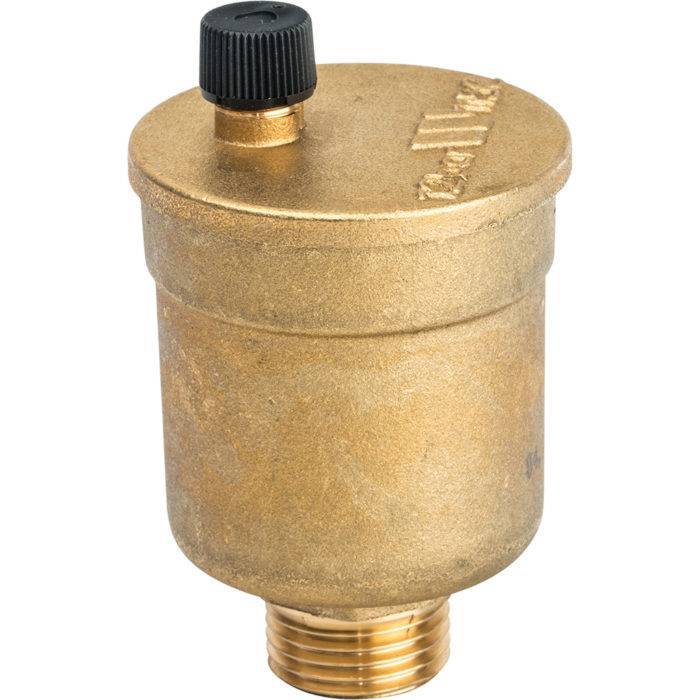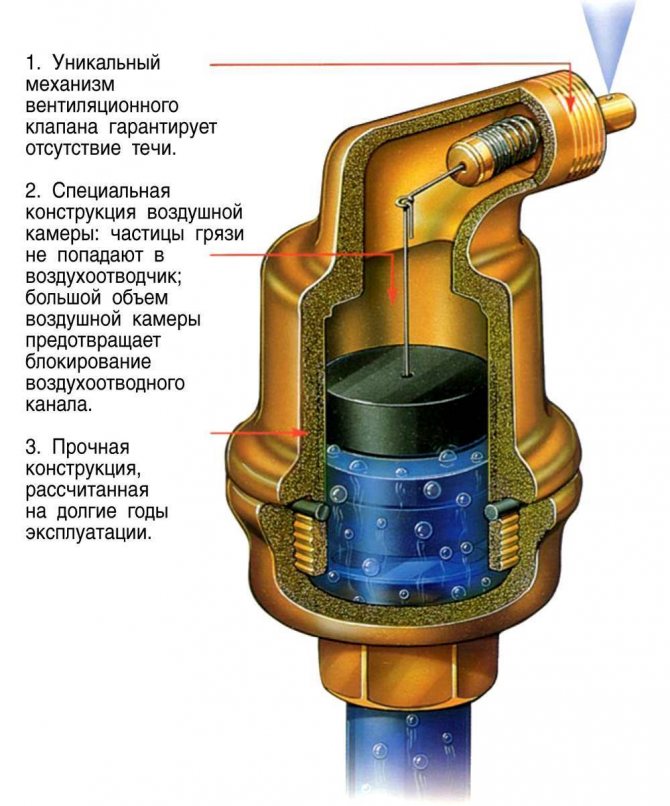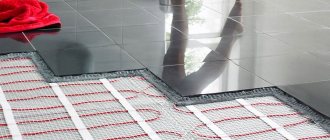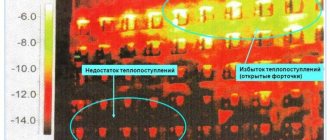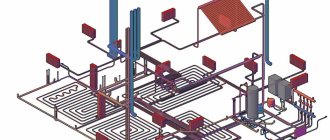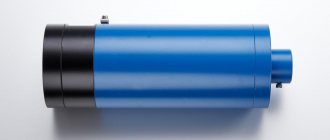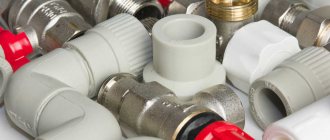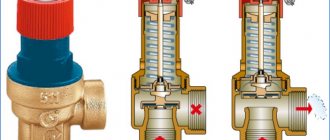Why is the air in the heating system dangerous?
When air appears in the heating system, a plug is formed. Because of this, one part of the pipeline remains cold, and the other too overheats. When air accumulates from all heating circuits in one place, the movement of the coolant completely stops. What does it threaten:
- When an air blockage appears in a closed loop, pressure builds up in the system. This triggers the safety valve.
- It will constantly work and remove water from the system until the heating equipment burns out.
- Sometimes, this pressure will rupture pipes.
To prevent this and eliminate the problem, an air vent is installed. In addition to these difficulties, the presence of air in the circuit will lead to oxidation of the pipe, the occurrence of rust and a decrease in the service life.
Why does air appear in the heating system
To discharge air accumulations in the pipe system, both inside the house and in the supply system, it is envisaged to install specialized cranes - air vents.
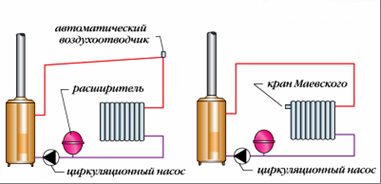
Heat pipes are capable of airing for the following key points:
- When the pipe system is quickly filled with water. Air collects in high places. Therefore, the process must be slow, with the make-up point at the bottom and the air outlet at the very top of the system, usually in the attic.
- Increased solubility of gases in the coolant with an increase in its temperature. For replenishment of large volumes of district or main heating networks, it is recommended to deaerate the water in special devices of the bubbling type. When the water temperature reaches 104 C, oxygen from the water goes into the atmosphere through the deaeration column.
- In the process of carrying out repair and restoration work related to the drainage of the coolant from the network section.
- As a result of corrosion processes, hydrogen is released on the inner surfaces of steel pipes, which gradually accumulates in heating networks.
- In case of violation of the integrity of the heating system.
Purpose and types of air vents
The air vent is designed to discharge air from the heating system and to avoid the appearance of air pockets. Air accumulation occurs during system operation or due to malfunctions. Sometimes this happens when the pipeline is filled with a coolant or when there is a loss of tightness in one of the mechanisms. There are 2 types of air vents, which differ from each other in design features:
- Mayevsky's hand cranes;
- automatic air valves.
Each device consists of a shell and a valve. The body has a threaded connection and a gasket, thanks to which it is attached to any part of the heating system. The outlet port is closed by a valve, which consists of a rubber gasket or is in the form of a cone. Depending on the model, the valve can operate in either automatic or manual mode.
Each product is suitable for installation anywhere in the system and works the same way. Solenoid valves for air have a straight and angle configuration, and Mayevsky's valves are made in a radiator and simple design.
How the device works
An air valve (or several) is installed in the heating system, in places most likely for the accumulation of air bubbles. This prevents the formation of a large congestion, the heating works smoothly.
We recommend that you familiarize yourself with: XLPE Pipe Fittings
Mayevsky crane
Such devices were named after the name of their developer. The Mayevsky crane has a thread and dimensions for a pipe with a diameter of 15 mm or 20 mm. It is arranged simply:
- In the body of the valve body, 2 through holes are made, which, in the open position of the Mayevsky crane, are connected to the heating system.
- These holes are sealed with a taper threaded screw.
- Air is discharged through a small (2 mm) opening directed upwards.
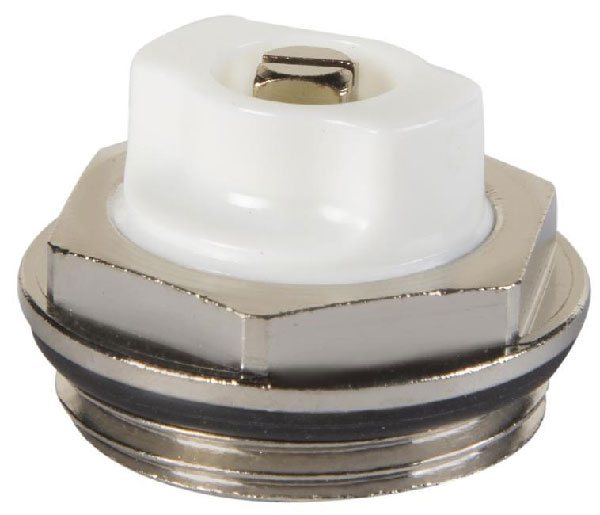

In order to bleed air from the system, unscrew the screw 1.5-2 turns. Air blows out with a whistle as communications are under pressure. The end of the airlock outlet is characterized by a drop in pressure and the appearance of water.
Note! The Mayevsky crane is a simple and reliable device for bleeding air accumulations. It does not clog or break because it has no moving parts. Its design is simple and reliable.
On the market, you can find several varieties of the Mayevsky crane, which are the same in design, but differ in the way of adjusting the locking screw. There are:
- with a comfortable handle for unscrewing by hand;
- with a regular head for a flat screwdriver;
- with a square head for a special key.
For an adult, the principle of unscrewing the locking screw does not matter. However, in a home with children, it is safer to use devices that must be unscrewed with a special device. Having unscrewed the usual tap with a comfortable handle, the child can scald with boiling water.
Automatic faucet
The automatic air relief valve is based on the principle of a float chamber, the design includes:
- vertical case with a diameter of 15 mm;
- float inside the body;
- a spring-loaded valve with a cover, which is connected and regulated by a float.
The automatic air valve for the heating system works without human intervention. Normally, when there is no air in the system, the float is pressed against the valve cover by the pressure of the liquid filler. At the same time, the lid is tightly closed.
We recommend that you familiarize yourself with: The use of plastic pipes for the organization of drainage systems
As air accumulates in the valve body, the float goes down. As soon as it drops to the critical level, the spring-loaded valve opens and bleeds out the air. Under the pressure of the carrier in the system, the space is again filled with liquid. The float rises to close the spring valve cover.
When there is no coolant in the communications, the float lies at the bottom of the valve. As the system fills, air leaves the tap in a continuous flow until the coolant reaches the float.
Note! A small amount of air is constantly present under the cover of the automatic valve. This is normal and does not affect work in any way.
A distinction is made between the following configurations of automatic air valves for heating:
- with vertical air discharge;
- with lateral air discharge (through a special jet);
- with bottom connection;
- with corner connection.
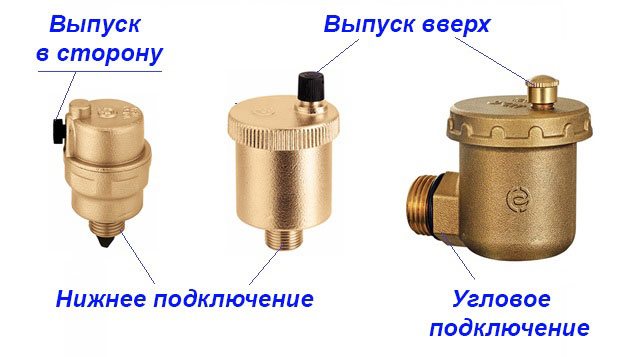

For the layman, the design features of an automatic crane do not matter. However, for a professional, there is a difference in choosing between devices.
It's believed that:
- a device with a nozzle and a side hole is more reliable in operation than an automatic valve with a vertical air discharge;
- The bottom-connected valve is more efficient at trapping air bubbles than the side-mounted valve.
If the design of the Mayevsky crane has not undergone changes for many years, then the device of automatic valves is constantly being improved and supplemented.
Manufacturers offer automatic valves with additional devices:
- with a membrane to protect against water hammer;
- with a shut-off valve, for the convenience of dismantling the device during the heating season;
- mini valves.
Note! The disadvantage of an automatic valve is that it gets dirty quickly. Limescale, debris clog the internal, moving parts of the device. This leads to a weakening of the efficiency of its work or complete failure.
Automatic air valves for heating need frequent inspection and cleaning. The undoubted advantages of these devices include the ability to install them in hard-to-reach places.
Where are the air release valves installed?
In open-type heating systems, air escapes through the expansion tank. But if the system is equipped with a pump for forced circulation of the coolant, then there is a possibility of air congestion. Therefore, in such systems, a manual or automatic air release device is installed. Installation locations of air vents, depending on different situations:
- On radiators, it is customary to install a manual air relief valve. It is mounted in this place because airing most often occurs at this point of the heating area. Therefore, they try to equip all radiators with devices.
- In the upper sections of the vertical risers (where bubbles are trying to penetrate), automatic devices of the direct type are installed. These are the most popular models, they are also mounted on underfloor heating collectors.
- If air has accumulated in a hard-to-reach place, such as the ends of dead-end branches, then corner and radiator models are used. The valve is connected to the system by means of a pipe.
- If the design of the circulation pump provides for the installation of an air vent, then it is mounted in order to improve the performance of the device. The airborne coolant is more difficult to pump over and slows down its operation. Because of this, it often stops, which leads to rapid wear of the bearings and impeller.
Valve types
Air valve is a sanitary device designed to bleed air from the heating circuit by diverting them outside. Available in two control options: manual and automatic.
Automatic air vent
The automatic air valve consists of a metal or plastic body in the shape of a cylinder or a cone. In its cavity there is a plastic float, which is connected through a flag with a rod with a needle-type shutter. To connect the valve to the elements of the heating system, its body is equipped with a threaded connection with a sealing gasket.
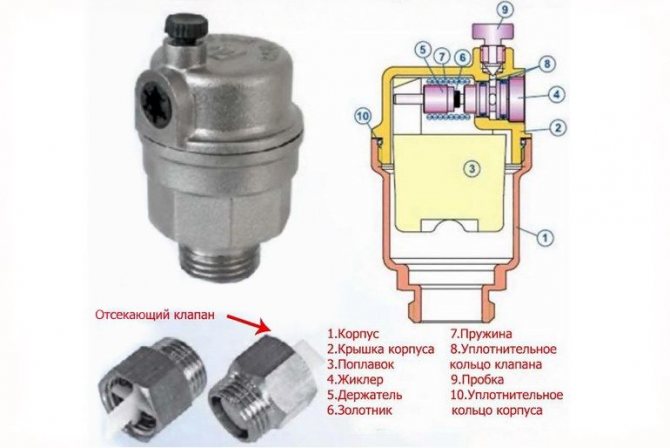

The air valve works as follows:
- Air entering the device body accumulates in its upper zone and gradually displaces the liquid. This lowers the float.
- When moving down, the float sets in motion the stem, which, in turn, drags the shutter body along with it. The valve opens and begins to release air to the outside.
- After removing the air, water fills the chamber of the instrument body again, forcing the float to move upward and close the vent hole. The device is in standby mode until the next venting process.
Some automatic air vent models are supplied with an adapter with an internal spring-loaded valve. It closes automatically when the device is dismantled.
By design, automatic air vents are of 3 types:
- straight pipe - for installation on vertical risers;
- pipe angled - mounted on horizontal pipe sections;
- radiator - for aluminum and bimetallic batteries.
Where are the valves and how they are mounted
To effectively remove air locks, valves should be installed in places where they are most likely to accumulate, namely:
- the highest points of the system, into which lighter air rushes;
- on a direct supply pipeline;
- separators, combs;
- in distribution manifolds of warm floor systems;
- heating boiler heat exchanger;
- on each water supply line to the collector;
- in front of the expansion tank;
- on the lines forming U-shaped loops.
An automatic air vent is installed with the nipple facing up, otherwise the float will not work.
A shut-off valve is used to connect to the pipe. A conventional open-end wrench is used to screw in the air vent, since the body has the shape of a hexagon from below.
Valve malfunctions and remedies
Due to the poor quality of the coolant, a hard salt deposit can accumulate on the valve needle, which prevents the outlet from closing tightly and the valve begins to leak. To fix this you need to:
- unscrew the housing cover:
- clean the locking piece and other elements of the assembly;
- reassemble the device structure.
Another malfunction may be the destruction of the gasket between the cover and the body of the device. In this case, water also oozes, but already from under the lid. This malfunction is eliminated by replacing the ring or by additional winding of the tape - fum on the threaded part in the body.
Manual air valve
The manual air valve is a Mayevsky tap. It is a cylindrical brass body with an external thread and a through hole, the overlap of which is carried out by means of a screw with a tapered end. The through hole is located in the center of the body, and a calibrated circular channel departs from it. When the screw is unscrewed, the passage to the side channel is released, through which the accumulated air moves to the outlet. After the gases are released, the screw is tightened to its original position.
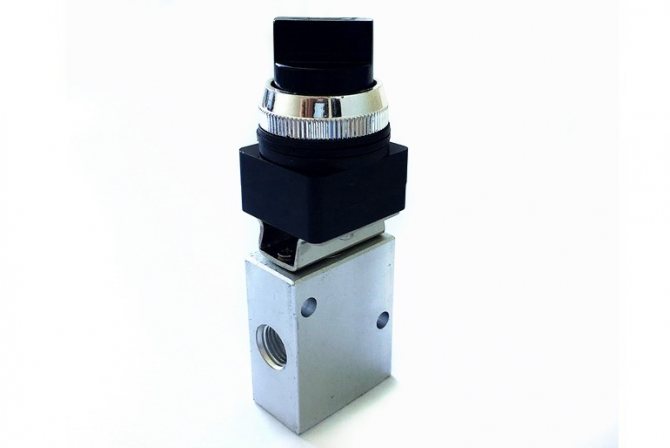

Mayevsky's cranes have differences in the method of unscrewing the screw:
- turning the stem head with a special key;
- non-removable handle;
- a slotted screwdriver if there is a straight slot (slot) on the stem head.
Where to put it right and how to mount it
The Mayevsky crane is installed from the end of the radiator, at its top point. For these purposes, the battery is shut off by the heating system taps, if there are none, the water is drained from the entire circuit. Then a blind plug is unscrewed from the radiator. In its place, a plug with a threaded hole is screwed in, and a tap is screwed into it. In this case, the following conditions must be met:
- the faucet drain must be turned away from the wall:
- the outlet channel should be slightly inclined downward, which will allow to substitute containers for draining part of the water.
Malfunctions and remedies
Contamination of the coolant can lead to obstruction of the drain hole. You can clean it with a regular needle, freeing the passage from the blockage.
If a leak appears from the tap, then it is better to replace it immediately.
Only defective products or with damaged threads by solid particles are not able to hold pressure. In both cases, the best solution is to replace the tap.
How to choose and install an air valve for heating?
Experts advise buying quality products from trusted suppliers, not cheap Chinese products. Air valve selection:
- products equipped with a shut-off valve are the best because they can be easily removed and replaced;
- in order not to use screwdrivers and keys, the Mayevsky crane is chosen with a handle;
- the best are those models that are equipped with additional functions;
- products covered with anodized protection are not subject to oxidation.
But before buying an air relief valve, you need to familiarize yourself with the technical characteristics of the heating equipment. For a two-story house, devices with an operating temperature of 100 ° C are used. They work efficiently at a pressure of 0.5-7 bar. Valve installation:
- The automatic air venting device is mounted vertically on the radiators. In this case, the cap that closes the outlet is directed upward. This arrangement is used for straight and angled models.
- The ball valve is mounted in front of the drain valve. This is a prerequisite, thanks to which the air vent can be removed at any time without draining the water. Sometimes a shut-off valve is installed instead of a ball valve.
- Installation of the Mayevsky crane is carried out with a wrench. Unlike an adjustable wrench, this tool makes it easier to track the tightening level of a fastener. To prevent the device from breaking during screwing, it is held by the hexagon located under the camera, and not by the body.
If air accumulates in a multi-storey building after replacing the radiators, then the air vent is mounted on each radiator located in the upper manifold.
Varieties of air valves
Air bubbles contained in the coolant tend to accumulate in certain places in the heating network and inside radiators. The formed bubble continues to be fed with new portions of oxygen and grows into an air lock, blocking the movement of heated water in this area. As a result, nearby batteries or radiator sections cool down.
To release air from the heating system, 2 types of valves are used:
- Mayevsky's manual crane;
- automatic air vent, float type.
Historical reference. During the Soviet era, such air separators were not used. In private houses, open-type schemes were used, where air went out through an expansion tank. The centralized heating networks of apartment buildings were equipped with air collectors and drain valves installed at the highest points, and sometimes in batteries.
How the drain valve works
The device of the Mayevsky valve shown in the drawing is easy to understand. In the end of the brass body with a ½ ”(DN 15) or ¾” (DN 20) external threaded connection, a Ø2 mm hole is made, whose cross-section covers the screw with a tapered tip. A small diameter hole is made in the side of the housing for air outlet.
Sectional drawing of the Mayevsky screw valve
Note. The redesigned air relief valve is equipped with a rotatable plastic insert, inside of which there is a branch duct. Conveniently, the position of the vent hole can be adjusted by turning the plastic washer.
The mechanical "air vent" works as follows:
- In heating operation mode, the locking screw is tightened and the cone seals the hole.
- When it is necessary to release the airlock, the screw is unscrewed by 1-2 turns. Under the pressure of the coolant, air passes through a hole with a diameter of 2 mm, enters the outlet channel and moves outward along it.
- First, clean air comes out of the hole, then mixed with water. The screw is tightened after a dense stream of coolant comes out of the channel.
Varieties of valves by unscrewing method
Mayevsky's air valve with a manual drive is a reliable tool for venting gases from pipelines and heating radiators. The secret of reliability is the absence of moving parts that can clog, wear out or rust. As a rule, the valve is used as a radiator air vent.
Manual air heating valves are divided into varieties according to the method of unscrewing the screw:
- using a plastic or metal handle;
- the traditional version is a slot for a flat screwdriver;
- square head screw to use the special wrench.
What is Mayevsky's crane and how it functions is clearly shown in the video from the master - plumber:
The principle of operation of the automatic air vent
It is easy to guess that this type of air relief valve operates without human intervention. The element is a vertical brass barrel with a G ½ “(DN 15) threaded connection, where a plastic float is placed. The latter is connected by a lever with a spring-loaded air relief valve mounted in the cover.
For reference. Automated air vents (in common parlance - auto air vents, drains or dumpers) are produced with two types of connecting external threads - ½ "and 3/8". But in the post-Soviet space, products with a half-inch thread are usually used, 3/8 is extremely rare.
The principle of operation of the automatic air vent is as follows:
- In operating mode, the chamber inside the body is filled with water, which presses the float upward. The spring loaded air valve is closed.
- As air accumulates in the upper zone of the chamber, the coolant level decreases and the float begins to fall.
- When the level drops to a critical value, the weight of the float overcomes the elasticity of the spring and the valve opens, air will begin to bleed out.
- Due to the excess pressure in the heating system, the water will displace all the air from the chamber of the device, take its place and raise the float again. The valve will close.
When the pipeline network is filled with a coolant, air is removed continuously while the float lies at the bottom of the tank. As soon as water fills the chamber, the spring will close the valve and the bleed will stop. Please note that some of the air mixture will remain inside the housing under the cover itself, which will not affect the normal operation of the heating in any way.
By design, air vents - automatic machines are available with direct and angular connection. Some manufacturers bring the discharge vertically upwards, others - to the side, from the side "spout" with a jet. From the point of view of the average homeowner, these differences do not matter much, but the master - the plumber will be told a lot.
Example. Experience has shown that a side outlet automatic valve works more reliably than a vertical outlet. Conversely, a product with an elbow fitting is less efficient at collecting air bubbles than a design with a direct bottom connection.
The device of automatic air vents is constantly being improved. Leading manufacturers of heating system parts endow their products with additional functions:
- Protection against water hammer by means of a reflective plate (placed at the entrance to the chamber).
- Effective trapping of small bubbles is achieved in a flow-through design with two horizontal branch connections. The lower zone of the increased volume of the tank is occupied by a special filler, which stops the moving air bubbles and collects them in the chamber.
It is worth unscrewing the element from the adapter, and the spring will close the passage with a plate
- Possibility to remove the air vent for service purposes without emptying the pipes. This is achieved by installing an automatic shut-off valve with a spring on the inlet connection. When the plumber unscrews the element, the spring straightens and the washer with the O-ring closes the passage, as shown in the diagram above.
- Embedding a mini-valve in a radiator plug (see photo).
Air valves designed as radiator plugs
Lyrical digression. Homeowners and some "experts" unknowingly call the float air vent an automatic Mayevsky crane, which is fundamentally wrong. The inventor Mayevsky in the 30s of the last century proposed the design of a manual crane, but he has nothing to do with the "machine".
How to get rid of an airlock?
Sometimes, due to improper pipe laying and illiterate engineering design, air locks appear in hard-to-reach places. It is difficult to remove air from there. Air bleeding process:
- You can determine the location of the plug by the murmur and cold section of the pipe. If these signs are absent, then the pipes are tapped. A loud and loud sound indicates an accumulation of air.
- In a private house, air cushions are expelled from the pipes by increasing the temperature or pressure. To do this, open the drain valve closest to the jam and the make-up valve. The coolant will fill the pipes, the pressure will rise, the plug will begin to move and exit through the valve. After all the air has escaped, the hissing will stop and the water pressure can be shut off.
- If the plug remains, then it is necessary to raise the temperature and pressure at the same time. The indicators are raised to the maximum level (do not exceed it, since it is dangerous).
If designed incorrectly, the problem will appear regularly and in the same place. To remove it, an air vent is connected to this place. For large highways, a tee is mounted. A valve is mounted on a free entrance.
How to choose an air vent: expert advice
- The Mayevsky crane works effectively only in the place of natural accumulation of air. It cannot independently catch air bubbles in the passing stream, since it is not equipped with an air chamber. When inserting a tap into the water supply system, it is additionally worth installing an air chamber. To do this, it is enough to install a branch pipe.
- It is worth paying attention to trusted manufacturers. Do not trust Chinese products: with a low price and attractive appearance, such devices do not work for long and cannot be repaired.
- When buying a device, do not neglect designs with an additional cut-off device, which will allow you to remove the crane at any time without shutting down the system.
Before buying, it is better to study the tables with characteristics provided by the manufacturers of heating equipment.
Good time of the day, dear reader! Air locks in the heating system have already caused a lot of inconvenience to many residents of apartment buildings. It would seem that the heating season has already begun, the system is filled with water, and the batteries in some rooms remain completely or partially cold. In this case, only the timely discharge of accumulated air from the heating devices will help. This can be done quickly via a heating air valve, which must be installed in the system during the assembly process.
Types of automatic air dumpers
In total, there are three types of these devices - despite this, the operation of the automatic air vent, or rather its principle, remains unchanged. In all cases, the same needle valve and the same float that opens and closes it are used - the only difference is in the position of the body relative to the connecting pipe, i.e. threaded connection.
Direct automatic
air valve for heating. The most common automatic venting device. It is intended only for vertical installation - in the sense that if you suddenly decide to use it for a battery, you will additionally need a corner at 90 degrees. The optimal area of their application is pipelines, or rather their upper points, where, according to all the laws of physics, the air formed in heating rushes. If it were not for such devices, then it would be very inconvenient to discharge air at the highest points of heating systems. In addition, some heating system equipment is equipped with automatic dumpers with straight connecting pipes.For example, the automatic air valve is an integral part of the boiler safety group, which also includes a pressure gauge and an explosion valve. Air vents are also equipped with indirect heating boilers and other equipment, at the top of which there is a possibility of air accumulation.

